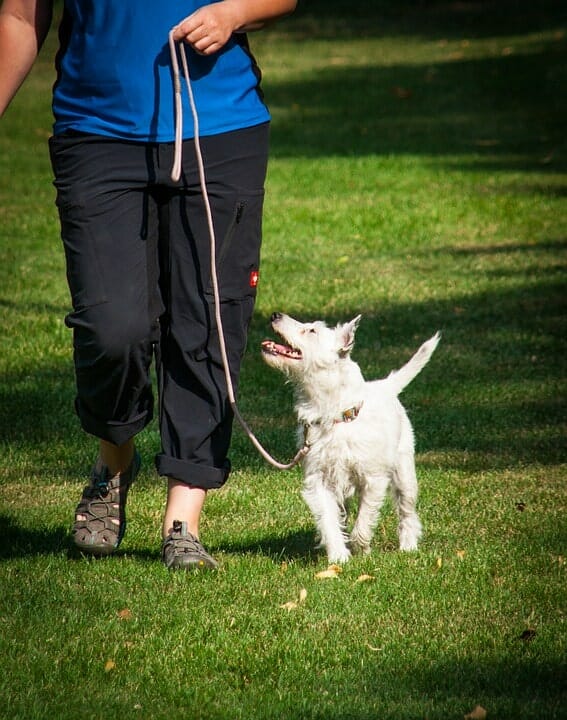
How Often Should You Walk Your Dog?
Can a dog be over-exercised or over-walked? What about puppies? This week, Nadia Crighton from Pet Insurance Australia takes a look at the importance of walking your dog and how to keep your puppy safe when you’re strolling the streets.
Dogs of varying ages and breeds require tailored exercise routines. It is essential, before purchasing any purebred or cross-breed, to examine the energy traits of the particular dog. Some breeds are extremely high-energy and require a lot more exercise than a lot of first-time owners might expect and will expect a good dose of exercise to keep them happy and out of trouble. And then, at the other end of the spectrum, you will find other dogs are much more partial to lazing about on a warm winter’s day. It all comes down to which breed you choose, but generally, bigger dogs require more exercise.
How Often Should I Walk My Dog?
Regular on-leash walks are essential for all dogs, regardless of their age, breed, or size. Most dogs require at least one daily walk per day.
On-leash walking can help provide your pet with leadership and a sense of security – AKA my human’s got this! It also makes vet visits much easier and allows you and your dog to bond and work in harmony. Training and on-leash walking allow you and your dog to share the same language.
If you are having trouble walking your dog on-leash, consider enlisting the help from a professional dog handler or obedience training professional.
How Long Should I Walk My Dog?
This will depend on your dog’s age and breed.
Highly energetic dogs may require a good hour of exercise per day. This can be broken into two 30 minute sessions. As a general rule a 30minute brisk walk in the morning, followed by a good off-leash run in the evening.
For non-working/herding breeds – a decent 30min run or walk would be sufficient to keep your dog happy, alongside some daily training sessions.
For smaller breeds a good play session or short walk, daily, is enough to keep them energized and healthy.
Both puppies and older dogs require special care. Puppies should not be over-exercised, and it’s recommended to engage them in short play and training sessions. As for older dogs, it’s advisable to limit long runs and prevent any form of jumping to ensure their well-being.
Go easy and note after each walking session how your dog is feeling. Are they stiff the next day? Or do they seem sluggish? If so, reduce the walk until your pet is at a suitable walking pace and level.
If you suspect your dog is in pain after any exercise, or is having difficulty lying down or getting up, or is starting to lick their joints, seek veterinary advice.
When Can I Start Walking Your Puppy?
With the recent COVID pet boom, we’ve been getting a lot of people asking ‘when can I take my puppy for a walk?’. Puppies need to have a gradual introduction to the outside world. Before your pup has had all its vaccinations, it can’t go for walks on its own. If you carry your pup, supervise where it goes, and clean up any messes (a good idea even after that), then you can walk your pup when it’s about 6 weeks old (though some breeds take longer).
If your pup is too young to go for walks alone, consider a small puppy playpen that you can put up near your home. Because their little legs are so weak, puppies can easily hurt themselves and get badly injured if they run around in the yard or neighbourhood.
Exercise and Socialization for Puppies
Before even thinking about walking a puppy, keep in mind that puppies need a lot of exercise, and not so much walking. Beginners who drive places every day can start walking their puppy at the age of 6 weeks, because the pup will soon be able to accompany you on a short car ride. For more information, check out our article on how much exercise puppies need.
A quick word about puppies that are not housebroke. When you first bring your pup home, it will probably be very scared of everything and everyone. It may even try to bite or snap at people or dogs it sees. This is normal behaviour for puppies and will pass quickly as the pup gets used to being around adults and other pets.
Can You Walk A Dog Too Much?
It is strongly advised, particularly for puppies, older dogs and giant breeds, not to over-exercise.
Do your homework and research on the exercise levels for each individual breed. Some breeds make the perfect jogging and adventure companions, while others do not.
Pups need extra care when exercising until they are fully grown to protect fast growing joints. Never over-exercise or over-walk your pet and learn the warning signs on when to stop.
A puppy needs a lot of sleep to grow into a well-rounded dog. If they become tired, pop them into a secure location like a crate or pen area so they can sleep undisturbed. It’s important with exercise to go with your pup’s pace. If they are looking tired, do not push them to keep walking or exercising.
Puppies should not be off-leash or walking in public spaces until after their last vaccination. For socialisation consider safer environments such as a puppy-preschool.
If your pet is showing signs of exhaustion stop immediately. It’s also a good idea to check the pavement before walking! If it is too hot for the back of your hand…it is too hot for your dog’s sensitive pads.
Avoid over-exerting giant breeds like Great Danes, especially during their puppy-hood, as it can harm their rapidly growing, large joints, potentially resulting in debilitating conditions in the future. It’s advisable to consult your breeder regarding the appropriate level of exercise for giant breeds.
Having pet insurance from a young age can assist with expenses in the event of injuries to your puppy or dog.
Also see:
Older Pet Care
Toxic Essential Oils for Dogs
How To Soothe A Dog’s Upset Stomach Naturally
Dog Bloated Stomach Home Remedy
Feeding A Golden Retriever for Optimum Health
What About Pet Insurance?
Over-exercising and over-walking may lead to joint problems, arthritis and other issues such as damaged pads and nails.
With pet insurance you could save up to 80% on eligible vet costs, depending on the type of cover, limits, exclusions and pre-existing conditions.
Our Major Medical pet insurance plan includes Routine Care Cover for dogs, which can contribute to covering the essential everyday care and expenses for your pet, with no excess. You can find more details in the Product Disclosure Statement.
Understanding Pre-Existing Conditions in Pet Insurance
When considering pet insurance, it’s crucial to take pre-existing conditions into account. These are symptoms or signs of a condition that occur before you purchase your policy or during the applicable waiting period. Pre-existing conditions are not eligible for coverage.
For instance, if your pet had treatment for a joint condition before obtaining your pet insurance policy, future joint issues would be considered ‘pre-existing,’ making claims for joint-related problems unavailable during your policy’s duration.
Please read the PDS to decide if this product is right for you.
This article was brought to you by Pet Insurance Australia, providing the best possible pet cover through our cat insurance and dog insurance plans.
Nadia Crighton is a renowned and accomplished professional in the fields of Journalism, Public Relations, and Writing, with an extensive career spanning over 25 years, 20 of which have been dedicated to promoting the health and well-being of pets.
Get the latest Pet Insider Tips & News
We offer award-winning* pet insurance policies to protect your furry friend’s health and wellbeing. Get a quote today and give your pets the care they deserve.
Archives
Categories
- Cat Care (64)
- Cats (1)
- Dog Care (124)
- Guides (28)
- Health and Nutrition (200)
- Lifestyle and Activities (219)
- Media Release (24)
- Pet Care (246)
- Rescue Dogs (1)


